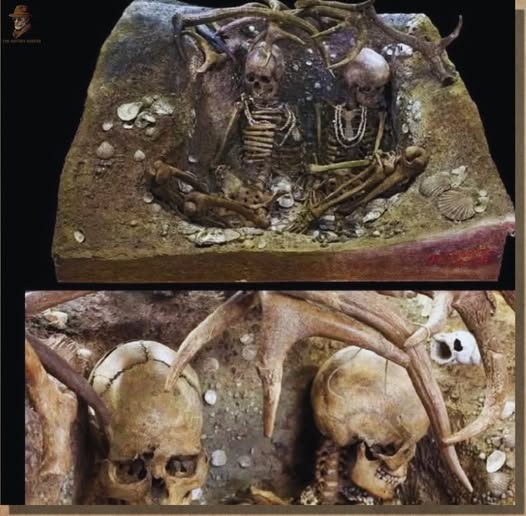
What if a single grave could unlock the secrets of a 9,000-year-old mystery?
admin
- 0
What if a single grave could unlock the secrets of a 9,000-year-old mystery? In Téviec, France, archaeologists uncovered the remains of two women whose lives—and violent deaths—offer a rare glimpse into the rituals, social structures, and emotional depth of prehistoric societies. Buried with extraordinary care beneath a roof of antlers and adorned with intricate shell necklaces, these women’s story is a haunting reminder of humanity’s timeless need for respect, remembrance, and connection.

A remarkable archaeological discovery in Téviec, France, has unveiled the lives and deaths of two women who lived between 6740 and 5680 BC, during the Mesolithic period. Their graves, meticulously excavated and preserved, reveal a level of care and reverence that challenges our assumptions about prehistoric societies. Despite evidence of violent deaths—visible in the trauma marks on their skeletal remains—their burial was anything but ordinary. The women were laid to rest beneath a symbolic “roof” made of antlers, a gesture that may have held spiritual or protective significance. They were also adorned with intricately strung shell necklaces, suggesting they held a position of importance or prestige within their community.

This burial was not a simple act of interment but likely a ritualistic event, reflecting the emotional and social complexity of the people who lived nearly 9,000 years ago. The antler roof and the shell ornaments hint at a society that valued symbolism, artistry, and the honoring of the dead. The discovery is even more extraordinary because of the way it was excavated: archaeologists took great care to preserve the grave in its entirety, ensuring that the arrangement of the bodies and artifacts remained intact. Today, these remains and their accompanying artifacts are housed at the Muséum de Toulouse, where they continue to captivate researchers and visitors alike.

The Téviec burial invites us to reflect on the lives of these women and the world they inhabited. Who were they? What role did they play in their community? And what led to their violent deaths? While we may never have all the answers, this discovery underscores the sophistication of prehistoric societies, their capacity for ritual and symbolism, and their deep sense of respect for the deceased. It is a poignant reminder that, even thousands of years ago, humans sought to honor their dead and preserve their memory.

Téviec is an island off the coast of Brittany, France, known for its rich archaeological sites dating back to the Mesolithic period. The discovery of these graves is part of a larger collection of burials found on the island, many of which show similar levels of care and ritual. The use of antlers and shells in burials suggests that these materials held significant cultural or spiritual meaning for the people of Téviec. The violent nature of the women’s deaths, possibly due to conflict or ritual sacrifice, adds another layer of intrigue to the find, highlighting the complexities of life in prehistoric times.
